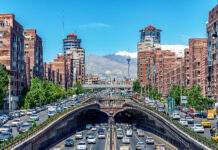Latest Developments
After nearly four years of impasse in peace negotiations over the decade-long conflict, between 27 and 29 April 2021, representatives of the Republic of Cyprus (Greek) and the Turkish Republic of Northern Cyprus met in Geneva to reach a final solution on the division that has held the Mediterranean island in check for over 50 years now. The meeting – organised under the auspices of the UN Security Council and Secretary General Antonio Guterres and with the presence of the Ministers of Foreign Affairs of Greece, Turkey and the United Kingdom – lasted three days, but did not produce the desired results. It is yet another deadlock even though Guterres has already announced further meetings.
Since the last talks in 2017 in Crans-Montana, Switzerland, the positions of the two states have not changed. While the Republic of Cyprus, part of the European Union, insists on creating a federation, its Turkish counterpart calls for the establishment of two states with equal sovereignty.
The situation has been further complicated in recent years by the oil fields off the island’s southern coast. While many European and non-European multinationals have been exploiting the resources for years, Turkey, the only state recognising the Turkish Republic of Northern Cyprus (defending it militarily), has also raised tensions by blocking an ENI ship and starting drilling without approval by the Republic of Cyprus. A crisis that lasted a year also led to a military escalation with Greece, a hypothetical peace a faraway dream.
Last November, the Turkish Cypriots elected Ersin Tatar as President, a man who supports Ankara and a two-state solution. He announced the opening of a tourist resort in a ghost town that has become a symbol of division. The strong tensions, somewhat dampened by a timid rapprochement in Geneva, have left the island in a state of perpetual concern for the future, dividing the population.
Nevertheless, there are some signs of progress, such as the election of the first Turkish Cypriot MP in Brussels, Niazy Kizilyürek, also voted for by Greek Cypriots and in favour of a united future. A gap in the Green Line in the centre of Nicosia has also been opened, even though the island remains divided by the United Nations Peacekeeping Force in Cyprus (UNFICYP) mission’s Blue Helmet forces, who have been there since 1964, when Greek nationalists attempted a coup to annex the island to Greece. This action was halted by the Turkish invasion of the north of the island, which triggered a war ten years later, the wounds of which have still not healed.
What is being fought for
Cyprus is militarily pacified thanks to the presence of the UNFICYP mission’s Blue Helmets who control the Green Line (Buffer Zone) separating Greek and Turkish territory. Although not impassable, it is still a border in the middle of a latent conflict between citizens of Greek and Turkish origin. The recent discovery of large natural gas deposits off the coast of Cyprus (Block 12 of the Exclusive Economic Zone, Eastern Mediterranean) has raised the level of conflict between the two sides. Furthermore, the Republic of Cyprus has also reached agreements on gas extraction with Israel, a state with unfriendly relations with Turkey. In 2013, in Nicosia, on the anniversary of the proclamation of the Turkish Republic of Northern Cyprus, hundreds of secondary and high school students took to the streets displaying banners with anti-Turkish inscriptions and chanting slogans against the Ankara government, in a reminder that underneath the apparent pacification there is no real peace. Meanwhile, a few kilometres to the north, in the Turkish-controlled part of the capital, former Turkish Cypriot President Dervis Eroglu attended a military parade along with other dignitaries. A few years ago, Turkish President Recep Tayyip Erdogan stated that “there is no such nation called Cyprus”, hinting at the complexity of finding an agreement.
Country Overview
Cyprus is the third largest island in the Mediterranean Sea, located 70 km south of Turkey and only 200 km from the coast of Syria and Lebanon. It has a total area of 9,250 km² of which 59% is under the effective control of the Republic of Cyprus, while the Turkish Cypriot area in the north covers about 36% of the territory. Two small areas, Akrotiri and Dhekelia, belong to the United Kingdom as sovereign military bases.
The highest peak on the island is Mount Olympus (1,953 metres), which rises in the Troodos Mountain range. “Mesaria is the fertile central plain of the island. The island was divided after a military invasion by Turkey in the summer of 1974. But how did this invasion come about? One must go back to 1955, the year in which a guerrilla movement, the Eoka (Ethniki Organosis Kyprion Agoniston, National Organisation of Cypriot Fighters) was formed in Cyprus in support of the Enosis (union, annexation) project (which had already existed for decades) to annex Cyprus to Greece. In 1960, Cyprus ceased to be a British colony and was proclaimed independent on the basis of the Treaty of Zurich and London between Turkey, Greece and the United Kingdom, in the presence of the Greek Cypriot leader, Archbishop Makarios III, and the Turkish Cypriot leader, Fazıl Küçük. On the basis of that understanding, the Constitution was drafted, and the project abandoned.
However, in 1967, a military dictatorship known as “the colonels” was established in Greece and Enosis, the idea of the annexation of Cyprus, came back to life. During his 1968 presidential campaign, Cypriot President Makarios III said that Enosis was impossible, and that the island’s independence was the only way. In reaction, the proponents of Enosis formed Eoka B with support by the Greek military government and the American CIA. In 1974, they organised a coup d’état to oust Makarios III. At this point, the armed forces of neighbouring Turkey landed in the north of Cyprus to prevent the Greek Cypriots from conquering the whole island and annexing it to Greece, and to protect the Turkish nationals who had been living there for a long time. In 1979 a “Turkish Cypriot Federated State” was proclaimed, which in 1983 became the Turkish Republic of Northern Cyprus (TRNC), recognised as a legal state only by Turkey (today, the Constitution of the TRNC is “legally invalid” based on UN Security Council Resolutions 541 of 1983 and 550 of 1984). The Republic of Cyprus (South) is instead internationally recognised and has been part of the EU since 2004.
On 11 November 2002, UN Secretary General Kofi Annan presented an initial plan for a resolution of the Cyprus problem, the so-called Annan I Plan, which was later revised considering the reactions of the two sides and re-proposed on 10 December 2002 under the name Annan II. This in turn gave rise to Annan III on 26 February 2003, which the Secretary General wanted to submit to the two communities as two separate referenda to be held simultaneously. However, it all remained on paper. In January 2004, Annan resumed negotiations, drawing up two more plans: Annan IV and Annan V. Cypriots were then asked to vote on Annan V on 24 April 2004, only a few days after the Republic of Cyprus’ entrance to the EU. Greek Cypriot voters overwhelmingly rejected the Plan with 75.8% of the vote, which was approved by 64.9% of Turkish Cypriot voters. Given the impasse and the delicate internal political balance, the UN still holds a military peacekeeping force on the island through the UNFICYP, sent to Cyprus back in 1964 to act as a buffer between the two communities that had lived in relative peace despite the episodes of violence ten years before the actual war, which broke out in 1974 and that even the presence of the Blue Helmets could not avert. UNFICYP soldiers permanently guard the “Green Line”, an area of about 350 km2 that divides the Turkish north and the Greek south, also cutting the capital Nicosia in two. The term “Green Line” originates from the line that General Peter Young, commander of the British forces on the island, drew (with a green pencil) on the map of Nicosia in 1964 to separate the Greek and Turkish quarters of the capital. Since April 2003, people are free to cross it and in 2008 the first crossing was opened in the historic centre of the capital, in Ledra Street.
FOCUS 1 – Oil, the new divisive element
The large oil fields off the southern coast of Cyprus are nothing new, considering that they were discovered at the beginning of the century and many nations in the region have been exploiting them for more than a decade. Today, the fields are mostly exploited by the multinationals ENI (Italy) and Total (France). Given the situation, Turkey wanted to have its share too, and this has increased tensions. In 2018, Ankara’s warships stopped an ENI vessel on its way to an oil site, creating a diplomatic issue. This was one episode among many that led the European Union to sanction Turkey in 2019 for continued exploration and drilling without the approval of the Republic of Cyprus and the EU, which considers it to be EU territory. Although financial sanctions were felt in Turkey last year, Ankara has not stopped sending ships to explore and drill. The latest of these, the Oruc Reis, which tried unsuccessfully to drill in the summer of 2020, escorted by naval vessels, almost sparked a conflict with Greece, also provoked by other Turkish drilling near the island of Rhodes not far from the Turkish coast.
Focus 2 – Geneva rekindles hope
The Geneva meetings, held between 27 and 29 April, have an important symbolic meaning after four years of press silence. The resumption of talks has raised hopes for a joint solution, although some sources say that the two sides are drifting away as time goes on. The Turkish Cypriot side is aiming at the creation of two separate states, while the Republic to the south is in favour of a reunification of the island. After three days of talks, however, the result was yet another deadlock. According to some experts, this is because a strong mediator is missing. However, UN Secretary General Antonio Guterres has announced that there will be further talks.
Key figure or organization: Ersin Tatar, a new president close to Ankara
In October 2020, Ersin Tatar was elected President of the Turkish Republic of Northern Cyprus. Very close to Recep Tayep Erdogan’s presidency in Turkey, he is considered by the international community and his Greek Cypriot counterpart as an obstacle to any progress in the negotiations, his being a strong supporter of the creation of two separate internationally recognised Cypriot states with equal rights. According to the new president, forty years of negotiations for a federation have come to nothing. Tatar won the election promising to bring a new “vision” where Cypriots can prosper together and in good relations on an equal footing. During the Geneva negotiations, he rejected the EU’s participation, considering it biased. In 2020, he also reopened the town of Varosha, abandoned during the war by about 40,000 Greek Cypriots, making it a tourist site.


















